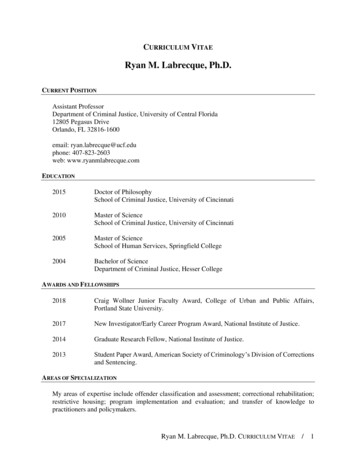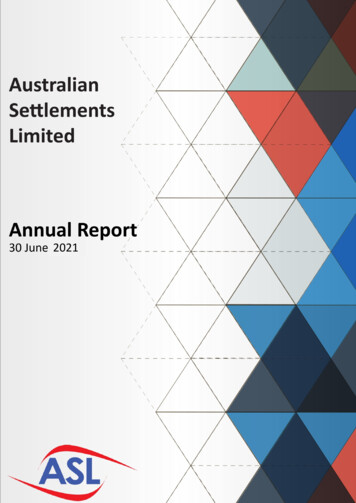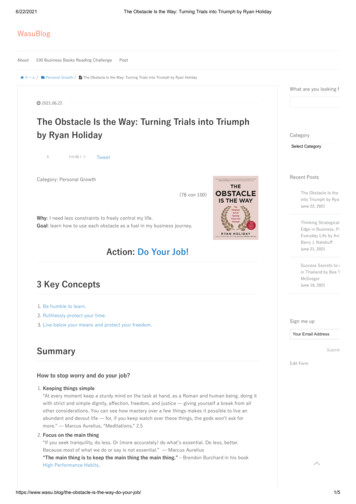
Transcription
CURRICULUM VITAERyan M. Labrecque, Ph.D.CURRENT POSITIONAssistant ProfessorDepartment of Criminal Justice, University of Central Florida12805 Pegasus DriveOrlando, FL 32816-1600email: ryan.labrecque@ucf.eduphone: 407-823-2603web: www.ryanmlabrecque.comEDUCATION2015Doctor of PhilosophySchool of Criminal Justice, University of Cincinnati2010Master of ScienceSchool of Criminal Justice, University of Cincinnati2005Master of ScienceSchool of Human Services, Springfield College2004Bachelor of ScienceDepartment of Criminal Justice, Hesser CollegeAWARDS AND FELLOWSHIPS2018Craig Wollner Junior Faculty Award, College of Urban and Public Affairs,Portland State University.2017New Investigator/Early Career Program Award, National Institute of Justice.2014Graduate Research Fellow, National Institute of Justice.2013Student Paper Award, American Society of Criminology’s Division of Correctionsand Sentencing.AREAS OF SPECIALIZATIONMy areas of expertise include offender classification and assessment; correctional rehabilitation;restrictive housing; program implementation and evaluation; and transfer of knowledge topractitioners and policymakers.Ryan M. Labrecque, Ph.D. CURRICULUM VITAE / 1
PUBLICATIONS[NOTE: Publications are arranged alphabetically by year. * denotes graduate student co-author.]ArticlesLabrecque, R. M., & Mears, D. (2019). Prison system vs. critics’ views on the use of restrictivehousing: Objective risk classification or ascriptive assignment? The Prison Journal, 99(2),194-218.Labrecque, R. M., & Smith, P. (2019). Assessing the impact of time spent in restrictive housingconfinement on subsequent measures of institutional adjustment among men in prison.Criminal Justice and Behavior. Advance on-line publication.Labrecque, R. M., & Smith, P. (2019). Reducing institutional disorder: Using the Inmate RiskAssessment for Segregation Placement (RASP) to triage treatment services at the front-end ofprison sentences. Crime and Delinquency, 65(1), 3-25. Reprinted in Corrections: A text/reader (3rd ed.) by M. K. Stohr, A. Walsch, and C. Hemmens(2018, Sage Publications).Labrecque, R. M. (2018). Taking stock: A meta-analysis of the predictors of restrictive housing.Victims and Offenders, 13(5), 675-692.Labrecque, R. M., Campbell, C. M., Elliot, J.*, King, M.*, Christmann, M.*, Page, K.*, McVay,J., & Roller, K. (2018). An examination of the inter-rater reliability and rater accuracy of theLevel of Service/Case Management Inventory (LS/CMI). Corrections: Policy, Practice andResearch, 3(2), 105-118.Labrecque, R. M., Scherer, H., & McCafferty, J. T. (2018). Reducing violence in correctionalinstitutions: Revalidation of the Inmate Risk Assessment for Violent, Nonsexual Victimization(RVNSV). Violence and Victims, 33(1), 126-141.Labrecque, R. M., Schweitzer, M., & Mattick, K. L.* (2018). A quasi-experimental evaluation ofa juvenile justice reinvestment initiative. Journal of Crime and Justice, 41(1), 49-61.Kennedy, J. P., Wilson, J. M., & Labrecque, R. M. (2017). Towards a more proactive approachto brand protection: Development of the Organizational Risk Assessment for Counterfeiting(ORAC). Global Crime, 18(4), 329-352.Labrecque, R. M., & Smith, P. (2017). Does training and coaching matter? An 18-monthevaluation of a community supervision model. Victims and Offender, 12(2), 233-252. Featured by the National Institute of Justice, Office of Justice Programs (2016).Morgan, R. D., Labrecque, R. M., Gendreau, P., Ramler, T.*, & Olafsson, B.* (2017,September/October). Questioning solitary confinement: Is administrative segregation as bad asalleged? Corrections Today, 79, 18-22, 78.Ryan M. Labrecque, Ph.D. CURRICULUM VITAE / 2
Schweitzer, M., Labrecque, R. M., & Smith, P. (2017). Reinvesting in the lives of youth: Atargeted approach to reducing recidivism. Criminal Justice Policy Review, 28(3), 207-219.Morgan, R. D., Gendreau, P., Smith, P., Gray, A. L., Labrecque, R. M., MacLean, N., Van Horn,S., Bolanos, A. D., Batastini, A. B., & Mills, J. F. (2016). Quantitative synthesis of the effectsof administrative segregation on inmates’ well-being. Psychology, Public Policy, and Law,22(4), 439-461.Labrecque, R. M., & Smith, P. (2015). Strategies for improving offender risk prediction: Anexamination of methods. Journal of Criminal Justice and Legal Issues, 3, 1-20. American Society of Criminology Division of Corrections and Sentencing Student Paper Award(2013).Labrecque, R. M., Smith, P., & Luther, J. D. (2015). A quasi-experimental evaluation of a modelof community supervision. Federal Probation, 79(3), 14-19.Labrecque, R. M., Luther, J., Smith, P., & Latessa, E. J. (2014, May/June). Responding to theneeds of probation and parole: The development of the Effective Practices in CommunitySupervision Model with Families. Offender Programs Report, 18(1), 1-2, 6, 11-13.Labrecque, R. M., Schweitzer, M., & Smith, P. (2014). Exploring the perceptions of the offenderofficer relationship in a community supervision setting. Journal of International CriminalJustice Research, 1, 31-46.Labrecque, R. M., Smith, P., Lovins, B. & Latessa, E. J. (2014). The importance of reassessment:How changes in the LSI-R risk score can improve the prediction of recidivism. Journal ofOffender Rehabilitation, 53(2), 116-128.Labrecque, R. M., Smith, P., & Wooldredge, J. (2014). Creation and validation of an inmate riskassessment for violent, nonsexual victimization. Victims and Offenders, 9(3), 317-333.Labrecque, R. M., Schweitzer, M., & Smith, P. (2013). Probation and parole officer adherence tothe core correctional practices: An evaluation of 755 offender-officer interactions. AdvancingPractices, 3, 20-23.Labrecque, R. M., Smith, P., Schweitzer, M., & Thompson, C. (2013). Targeting antisocialattitudes in community supervision using the EPICS model: An examination of change scoreson the Criminal Sentiment Scale. Federal Probation, 77(3), 15-20.Smith, P., Labrecque, R. M., Smith, W. E., & Latessa, E. J. (2012). Development andimplementation of a case review conference model for juveniles: A structured approach tolearning from unsuccessful probationers. Federal Probation, 76(3), 3-7.Smith, P., Schweitzer, M., Labrecque, R. M., & Latessa, E. J. (2012). Improving probationofficers’ supervision skills: An evaluation of the EPICS model. Journal of Crime and Justice,35(2), 189-199.Ryan M. Labrecque, Ph.D. CURRICULUM VITAE / 3
ChaptersLabrecque, R. M. (2019). Issue 16: Solitary confinement. In B. Crank & C. Marcum (Eds.),Controversial issues in criminal justice: An active learning approach. San Diego, CA:Cognella Academic Publishing.Labrecque, R. M. (2019). Segregation in prisons, administrative. In R. D. Morgan (Ed.),Encyclopedia of criminal psychology. Thousand Oaks, CA: Sage Reference.Labrecque, R. M. (2019). Segregation in prisons, disciplinary. In R. D. Morgan (Ed.),Encyclopedia of criminal psychology. Thousand Oaks, CA: Sage Reference.Labrecque, R. M., & Smith, P. (2019). The impacts of restrictive housing: A systematic reviewof the evidence. In B. Huebner & N. Frost (Eds.), Handbook on corrections and sentencing(Vol. 3): The collateral consequences of punishment (pp. 290-310). New York, NY: Routledge.Gendreau, P., & Labrecque, R. M. (2018). The effects of administrative segregation: A lesson inknowledge cumulation. In J. Wooldredge & P. Smith (Eds.), Oxford handbook on prisons andimprisonment (pp. 340-366). Oxford, UK: Oxford University Press.King, M.*, & Labrecque, R. M. (2018). Prison escapes. In V. B. Worley & R. M. Worley (Eds.),American prisons and jails: An encyclopedia of controversies and trends in American prisons(pp. 206-208). Santa Barbara, CA: ABC-CLIO, LLC.King, M.*, & Labrecque, R. M. (2018). Typology of correctional officers. In V. B. Worley & R.M. Worley (Eds.), American prisons and jails: An encyclopedia of controversies and trends inAmerican prisons (pp.136-138). Santa Barbara, CA: ABC-CLIO, LLC.Labrecque, R. M. (2018). Probation in the United States: A historical and modern perspective. InO. H. Griffin & V. Woodward (Eds.), Handbook of corrections in the United States (pp. 155164). New York, NY: Routledge.Labrecque, R. M. (2018). Specialized or segregated housing units: Implementing the principlesof risk, needs, and responsivity. In K. D. Dodson (Ed.), Handbook of offenders with specialneeds (pp. 69-83). New York, NY: Routledge.Smith, P., Mueller, L. M.*, & Labrecque, R. M. (2018). Employment and vocation programs inprison. In J. Wooldredge & P. Smith (Eds.), Oxford handbook on prisons and imprisonment(pp. 454-472). Oxford, UK: Oxford University Press.Labrecque, R. M. (2016). The use of administrative segregation and its function in the institutionalsetting. In M. Garcia (Ed.), Restrictive housing in the U.S.: Issues, challenges, and futuredirections (pp. 49-84). Washington, DC: National Institute of Justice. Volume received an Award of Excellence from the National Association of GovernmentCommunicators (2017).Schweitzer, M., Labrecque, R. M., & Smith, P. (2014). Rehabilitation. In B. Arrigo (Ed.),Encyclopedia of criminal justice ethics (pp. 784-788). Thousand Oaks, CA: Sage Reference.Ryan M. Labrecque, Ph.D. CURRICULUM VITAE / 4
Labrecque, R. M., & Smith, P. (2013). Advancing the study of solitary confinement. In J.Fuhrmann & S. Baier (Eds.), Prisons and prison systems: Practices, types, and challenges (pp.57-70). Hauppauge, NY: Nova Science Publishers.Online MediaLabrecque, R. M. (2018, April 17). How a new inmate triage system could reduce the use ofsolitary confinement and improve prison safety. The London School of Economics and PoliticalScience, USAPP American Politics and Policy blog (http://bit.ly/2H9hkgi).Manuscripts Under ReviewAaby, M.*, & Labrecque, R. M. (under review). An assessment of sentencing disparities amongAmerican Indians within the Eighth, Ninth, and Tenth Federal Circuit Courts. Revised andresubmitted to Corrections: Policy, Practice and Research.Campbell, C. M., & Labrecque, R. M. (under review). Panacea or poison: Can propensity scoremodeling strategies replicate the results of randomized controlled trials in criminal justiceresearch? Revised and resubmitted to Journal of Quantitative Criminology.Campbell, C. M., Labrecque, R. M., Sanchagrin, K., & Weinerman, M. (under review). Assessingthe impact of pretrial detention on sentencing outcomes using propensity score matching.Submitted to Justice Quarterly.Campbell, C. M., Schaefer, R., LaBranche, K.*, Macias, K. R.*, Harvis, M.*, & Reddy, L.* (underreview). Fairness and respect in corrections: Examining the role of procedural justice inreducing harm and disorder in prison. Submitted to Criminal Justice and Behavior.LaBranche, K.*, & Labrecque, R. M. (under review). Public support for solitary confinement: Arandomized experiment of belief updating and confirmation bias. Submitted to Journal ofExperimental Criminology.Labrecque, R. M., Mears, D., & Smith, P. (under review). Gender and the effect of disciplinarysegregation on prison misconduct. Revised and resubmitted to the Criminal Justice PolicyReview.Motz, R. T.*, Labrecque, R. M., & Smith, P. (under review). Gang affiliation, restrictive housing,and institutional misconduct: Does disciplinary segregation suppress or intensify gangbehavior? Submitted to Punishment and Society.FUNDED RESEARCHExamining justice reinvestment in Oregon: Isolating effects of pretrial detention on prisonsentences. Funded by the Oregon Criminal Justice Commission, 2019 for 9,999. CoPrincipal Investigator with Christopher M. Campbell.Ryan M. Labrecque, Ph.D. CURRICULUM VITAE / 5
Interpersonal violence and institutional misconduct in jails: An empirical investigation of adverseevents in the Los Angeles County Jail System. Funded by the National Institute of Justice NewInvestigator/Early Career Program in the Social and Behavioral Sciences and Science,Technology, Engineering, and Mathematics (STEM) Grant (Award #2017-IJ-CX-0037), 20182019 for 184,636. Principal Investigator.Preparing high-risk inmates for successful reentry: Development and evaluation of a restrictivehousing step down program in Oregon. Funded by the Charles Koch Foundation, 2018-2019for 110,000. Co-Principal Investigator with David C. Pyrooz and Bert Useem.The creation and validation of the Oregon Public Safety Checklist-Revised (PSC-R). Funded bythe Oregon Department of Corrections, 2018-2019 for 35,000. Co-Principal Investigatorwith Kris Henning.Evaluation of a cognitive-behavioral program for inmates in administrative segregation. Fundedby the Bureau of Justice Assistance, FY16 Encouraging Innovation: Field Initiated ProgramsGrant (Award #2016-AJ-BX-K048), 2017-2020 for 461,900. Co-Principal Investigatorwith Paula Smith.Panacea or poison: Can propensity score modeling (PSM) methods replicate the results fromrandomized control trials (RCTs)? Funded by National Institute of Justice, FY16 Analysis ofExisting Data Grant (Award #2016-R2-CX-0030), 2017 for 39,972. Co-PrincipalInvestigator with Christopher M. Campbell.Fairness and respect in corrections: Examining the role of procedural justice in reducing harmand disorder in prison. Funded by Portland State University, Hatfield Public Service Grant,2016-2017 for 2,621. Co-Principal Investigator with Christopher M. Campbell.Evaluation of the California Department of Corrections and Rehabilitation (CDCR) SecurityHousing Unit (SHU) Step Down Program (SDP). Funded by Portland State University, FacultyEnhancement Grant, 2016-2017 for 15,000. Principal Investigator.Evaluation of the adult work release program in Hamilton County, Indiana. Funded by HamiltonCounty Community Corrections, 2016 for 35,000. Principal Investigator Paula Smith.Consultant.Evaluation of incentives and sanctions for community corrections. Funded by the Indiana JudicialCenter, 2015-2016 for 120,000. Principal Investigator Paula Smith. Consultant.A quantitative evaluation of the effect of solitary confinement on institutional behavior. Fundedby the University of Cincinnati School of Criminal Justice, Doctoral Student Research Grant,2014-2015 for 2,500. Principal Investigator.A quantitative evaluation of the effect of solitary confinement on institutional behavior. Funded bythe University of Cincinnati College of Education, Criminal Justice, and Human Services,Graduate Student and Faculty Research Mentoring Grant with Paula Smith, 2014-2015 for 1,000.Ryan M. Labrecque, Ph.D. CURRICULUM VITAE / 6
Implementation and evaluation of case management and evidence-based community supervisionpractices. Funded by the Indiana Judicial Center, 2014-2015 for 500,000. PrincipalInvestigator Paula Smith. Consultant.Re-analysis of probation workload measures data. Funded by the Indiana Judicial Center, 20142015 for 15,000. Principal Investigator Paula Smith. Consultant.Reducing prison misconduct with evidence-based administrative segregation policies. Funded bythe National Institute of Justice, Graduate Research Fellowship (GRF) Grant (Award #2014IJ-CX-0003), 2014-2015 for 32,000. Principal Investigator.A quasi-experimental evaluation of a model of community supervision. Funded by the Universityof Cincinnati School of Criminal Justice, Doctoral Student Research Grant, 2013-2014 for 2,500. Principal Investigator.A quasi-experimental evaluation of a model of community supervision. Funded by the Universityof Cincinnati College of Education, Criminal Justice, and Human Services, Graduate Studentand Faculty Research Mentoring Grant with Paula Smith, 2013-2014 for 1,000.Development of a schedule of progressive probation incentives and sanctions. Funded by theIndiana Judicial Center, 2013-2014 for 70,000. Principal Investigator Paula Smith. ProjectDirector.The effects of solitary confinement on inmate behavior. Funded by the University of CincinnatiSchool of Criminal Justice, Doctoral Student Research Grant, 2012-2013 for 2,500. PrincipalInvestigator.Exploring the perceptions of the offender-officer relationship in a community supervision setting.Funded by the University of Cincinnati College of Education, Criminal Justice, and HumanServices, Graduate Student and Faculty Research Mentoring Grant with Paula Smith, 20112012 for 1,000.Exploring the perceptions of the offender-officer relationship in a community supervision setting.Funded by the University of Cincinnati School of Criminal Justice, Doctoral Student ResearchGrant, 2011-2012 for 2,500. Principal Investigator.Evaluation of the adult work release/electronic monitoring program in Hamilton County, Indiana.Funded by Hamilton County Community Corrections, 2011-2013 for 35,000 per annum.Principal Investigator Paula Smith. Project Manager.Evaluation of the Effective Practices in Community Supervision (EPICS) model in Ohio. Fundedby the Ohio Office of Criminal Justice Services, 2010-2011 for 105,421. PrincipalInvestigators Edward Latessa and Paula Smith. Research Assistant.Technical Reports[NOTE: Publications are arranged alphabetically by year. * denotes graduate student co-author.]Ryan M. Labrecque, Ph.D. CURRICULUM VITAE / 7
Campbell, C. M., & Labrecque, R. M. (2019). Effect of pretrial detention in Oregon. Prepared forthe Oregon Criminal Justice Commission in Salem, OR.Henning, K., & Labrecque, R. M. (2019). The creation and validation of the Oregon Public SafetyChecklist-Revised (PSC-R). Prepared for the Oregon Department of Corrections in Salem, OR.Campbell, C. M., & Labrecque, R. M. (2018). Panacea or poison: Can propensity score modeling(PSM) methods replicate the results from randomized control trials (RCTs)? Washington, DC:National Institute of Justice.Campbell, C. M., Labrecque, R. M., Harvis, M.*, Macias, K. R.*, Reddy, L.*, & LaBranche, K.*(2018). Fairness and respect in institutional corrections: Examining the role of proceduraljustice in reducing harm and disorder in prison. Prepared for the Maine Department ofCorrections in Augusta, ME.Smith, P., Mueller, L. M.*, & Labrecque, R. M. (2018). Evaluation of a schedule of progressiveincentives and sanctions for community supervision. Prepared for the Indiana Judicial Centerin Indianapolis, IN.Smith, P., Motz, R.*, & Labrecque, R. M. (2018). Evaluation of the Hamilton County CommunityCorrections Adult Residential Program: Fiscal years 2013-2014, 2014-2015, 2015-2016, and2016-2017. Prepared for the Hamilton County Community Corrections in Noblesville, IN.Labrecque, R. M. (2015). The effect of solitary confinement on institutional misconduct: Alongitudinal evaluation. Washington, DC: National Institute of Justice.Labrecque, R. M., & Schweitzer, M. (2013). Targeted RECLAIM: 2012 University of Cincinnatioutcome study. Prepared for the Ohio Department of Youth Services in Columbus, OH.Latessa, E. J., Smith, P., Schweitzer, M., & Labrecque, R. M. (2013). Evaluation of the EffectivePractices in Community Supervision model (EPICS) in Ohio. Prepared for the Office ofCriminal Justice Services in Columbus, OH.Smith, P., & Labrecque, R. M. (2013). Evaluation of the Hamilton County CommunityCorrections Adult Residential and Electronic Monitoring Program: Fiscal years 2011-2012,2012-2013. Prepared for the Hamilton County Community Corrections in Noblesville, IN.Labrecque, R. M., & Schweitzer, M. (2012). Targeted RECLAIM: University of Cincinnatioutcome study. Prepared for the Ohio Department of Youth Services in Columbus, OH.Latessa, E. J. & Labrecque, R. M. (2012). Results from the National Criminal Justice TreatmentPractices Survey at the Riverbend Correctional Facility. Prepared for the RiverbendCorrectional Facility in Milledgeville, GA.Latessa, E. J. & Labrecque, R. M. (2012). Results from the National Criminal Justice TreatmentPractices Survey at the Washington Department of Corrections. Prepared for the WashingtonDepartment of Corrections in Tumwater, WA.Ryan M. Labrecque, Ph.D. CURRICULUM VITAE / 8
Schweitzer, M., Brusman-Lovins, L., & Labrecque, R. M. (2012). Targeted RECLAIM qualityassurance project: University of Cincinnati status report. Prepared for the Ohio Departmentof Youth Services in Columbus, OH.Smith, P., & Labrecque, R. M. (2012). Evaluation of the Hamilton County CommunityCorrections Adult Residential Program: Fiscal Years 2010-2011, 2011-2012. Prepared for theHamilton County Community Corrections in Noblesville, IN.Smith, P., Labrecque, R. M., & Thompson, C. (2012). Evaluation of the Hamilton CountyCommunity Corrections Electronic Monitoring Program: Fiscal years 2009-2010, 2010-2011.Prepared for the Hamilton County Community Corrections in Noblesville, IN.Schweitzer, M., Brusman-Lovins, L., & Labrecque, R. M. (2011). Targeted RECLAIM qualityassurance project: University of Cincinnati status report. Prepared for the Ohio Departmentof Youth Services in Columbus, OH.Smith, P., & Labrecque, R. M. (2011). Summary of case review conferences for Hamilton CountyJuvenile Court. Prepared for the Hamilton County Juvenile Court in Cincinnati, OH.RESOURCES FOR PRACTITIONERS2019Public Safety Checklist-Revised (PSC-R). Co-authored with Kris Henning.2017Inmate Risk Assessment for Segregation Placement (RASP). Co-authored with PaulaSmith.2014Inmate Risk Assessment for Violent Nonsexual Victimization (RVNSV). Co-authoredwith Paula Smith and John Wooldredge.PRESENTATIONS[NOTE: Presentations are arranged alphabetically by year. * denotes graduate student copresenter.]WebinarsCampbell, C. M., & Labrecque, R. M. (2019, February). Can PSM strategies replicate RCTresults in criminal justice research? A meta-analytic investigation. Hosted by the JusticeResearch and Statistical Association.Invited PresentationsCampbell, C. M., & Labrecque, R. M. (2019, May). Effect of pretrial detention in Oregon.Presented to the House and Senate Judiciary Committees in Salem, OR.Labrecque, R. M., Dobbs, G., Heiden, Z., & Skibba, R. (2019, April). Solitary confinement:Restorative or ruthless? Participant in debate at the Berkeley Forum in Berkeley, CA.Ryan M. Labrecque, Ph.D. CURRICULUM VITAE / 9
Campbell, C. M., Labrecque, R. M., Sanchagrin, K., & Weinerman, M. (2019, February).Examining the effect of pretrial detention in Oregon sentencing. Presented at the OregonJustice Reinvestment Summit and What Works in Public Safety Conference Summit inSalem, OR.Labrecque, R. M. (2018, August). Security Threat Management Re-Alignment Initiative.Presented at Oregon Department of Corrections Inspector General Annual CORE Retreat andTraining in Woodburn, OR.Smith, P., & Labrecque, R. M. (2017, September). Using incentives and sanctions in communitysupervision. Presented at the Probation Officers Professional Association of Indiana FallConference in French Lick, IN.Henning, K., & Labrecque, R. M. (2017, February). Risk assessment in criminal justice. Presentedat the Oregon Justice Reinvestment Summit and What Works in Public Safety ConferenceSummit in Salem, OR.Labrecque, R. M., Pompoco, A.*, & Lugo, M.* (2016, August). Research panel oncorrections. Panel discussant at the University of Cincinnati Criminal Justice Ph.D.Program Teaching and Research 25th Anniversary Celebration Conference in Cincinnati,OH.Smith, P., Labrecque, R. M., & Aning, D. (2016, April). Re-analysis of the probationworkload study data. Presented to the Indiana Judicial Center in Indianapolis, IN.Labrecque, R. M. (2016, May). Domestic violence risk assessments: Considerations for selectionand use. Presented to the House and Senate Judiciary Committees in Salem, OR.Labrecque, R. M. (2016, May). Reducing the use of segregation and maintaining institutionalsafety: How using a risk assessment may help. Presented to the Los Angeles CountySheriff’s Department in Los Angeles, CA.Labrecque, R. M. (2015, October). Who ends up in administrative segregation? Predictors andother characteristics. Presented at the National Institute of Justice meeting on the use ofadministrative segregation in the United States in Arlington, VA.Smith, P., Labrecque, R. M., Warner, J., & Mattick, K. L. (2014, November). Integrating the RNRframework into community supervision: A review of strategies to enhance fidelity. Presentedat the meeting of the Collaboration of Researchers for the Effective Development of OffenderSupervision (CREDOS) in San Francisco, CA.Smith, P., Schweitzer, M., Labrecque, R. M., & Latessa, E. J. (2011, September). Thedevelopment and implementation of an evidence-based, cognitive-behavioral treatmentcurriculum for sex offenders. Presented at the annual meeting of the International CommunityCorrections Association in Cincinnati, OH.Ryan M. Labrecque, Ph.D. CURRICULUM VITAE / 10
Paper PresentationsCampbell, C. M., Labrecque, R. M., Weinerman, M., Sanchagrin, K. (2019, November). Preppingdefendants for prison: Examining the effects of pretrial detention on sentencing. To bepresented at the annual meeting of the American Society of Criminology in San Francisco, CA.Labrecque, R. M., & Prins, C. A. (2019, November). Revalidation of the inmate risk assessmentfor segregation placement (RASP): Implications for policy and practice in Oregon. To bepresented at the annual meeting of the American Society of Criminology in San Francisco, CA.Labrecque, R. M. (2019, September). An empirical approach toward reducing violence in jail:The development and validation of the Inmate Risk Assessment for Perpetration (IRAP) andthe Inmate Risk Assessment for Victimization (IRAV). To be presented at the annual meeting ofthe Southern Criminal Justice Association in Nashville, TN.Labrecque, R. M., & Gendreau, P. (2019, May). Is solitary confinement an effective punisher ofprison misconduct? Theory and meta-analysis. In R. D. Morgan (Chair), symposium onAdministrative segregation: Who is in, is it harmful, and is it effective? conducted at the fourthmeeting of the North American Correctional and Criminal Justice Psychology (N4) Conferencein Halifax, Canada.Campbell, C. M., & Labrecque, R. M. (2019, March). Examining justice reinvestment in Oregon:Isolating effects of pretrial detention on prison sentences. Presented at the annual meeting ofthe Academy of Criminal Justice Sciences in Baltimore, MD.Labrecque, R. M., Gendreau, P., Morgan, R. M., & King, M. (2019, February). Revisiting theWalpole prison solitary confinement study: A content analysis. Presented at the annual meetingof the Western Society of Criminology in Honolulu, HI.Campbell, C. M., & Labrecque, R. M. (2018, November). How reliable is propensity scoremodeling in criminal justice? Follow-up findings from meta-analyzed tests of PSM. Presentedat the annual meeting of the American Society of Criminology in Atlanta, GA.Labrecque, R. M., & Smith, P. (2018, November). The impact of restrictive housing on inmatebehavior: A systematic review of the evidence. Presented at the annual meeting of the AmericanSociety of Criminology in Atlanta, GA.Campbell, C. M., Labrecque, R. M., Schaefer, R., Harvis, M.*, Macias, K. R.*, Reddy, L.*, &LaBranche, K.* (2018, February). Fairness and respect in institutional corrections: Examiningthe role of procedural justice in reducing harm and disorder in prison. Presented at the annualmeeting of the Academy of Criminal Justice Sciences in New Orleans, LA.Labrecque, R. M., & Smith, P. (2018, February). Creation and validation of the Inmate RiskAssessment for Segregation Placement (RASP). Presented at the annual meeting of theAcademy of Criminal Justice Sciences in New Orleans, LA.Campbell, C. M., & Labrecque, R. M. (2017, November). Panacea or poison: Can propensityscore modeling replicate the results from randomized control trials? — Part I. Presented at theAmerican Society of Criminology in Philadelphia, PA.Ryan M. Labrecque, Ph.D. CURRICULUM VITAE / 11
Labrecque, R. M., & Campbell, C. M. (2017, November). Panacea or poison: Can propensityscore modeling replicate the results from randomized control trials? — Part II. Presented atthe American Society of Criminology in Philadelphia, PA.Aning, D., Smith, P., & Labrecque, R. M. (2017, July). The effect of disciplinary segregation onjuvenile inmates: A propensity score analysis. Presented at the annual meeting of theInternational Academy of Law and Mental Health in Prague, Czech Republic.Smith, P., & Labrecque, R. M. (2017, July). The effect of long-term exposure to solitaryconfinement on institutional misconduct: A propensity score analysis. Presented at the annualmeeting of the International Academy of Law and Mental Health in Prague, Czech Republic.Campbell, C. M., Labrecque, R. M., Mohler, M.*, & Christmann, M.* (2017, March).Comparisons in parole supervision: Assessing gendered responses to technical violationsanctions. Presented at the annual meeting of the Academy of Criminal Justice Sciences inKansas City, MO.Labrecque, R. M., Scherer, H., & McCafferty, J. T. (2017, March). Reducing violence incorrectional institutions: Revalidation of the Inmate Risk Assessment for Violent, NonsexualVictimization (RVNSV). Presented at the annual meeting of the Academy of Criminal JusticeSciences in Kansas City, MO.Motz, R.*, Labrecque, R. M., & Smith, P. (2017, March). The effect of gang affiliation on postsolitary confinement institutional misconduct. Presented at the annual meeting of the Academyof Criminal Justice Sciences in Kansas City, MO.Labrecque, R. M. (2016, November). Assessing for racial disparity in the use and effects ofdisciplinary segregation: A propensity score matching analysis. Presented at the annualmeeting of the American Society of Criminology in New Orleans, LA.Labrecque, R. M., Smith, P., & Gendreau, P. (2015, November). Gender-based differences in theeffects of solitary confinement on institutional behavior. Presented at the annual meeting of theAmerican Society of Criminology in Washington, DC.Smith, P., Labrecque, R. M., & Gendreau, P. (2015, July). An evaluation of the impact of solitaryconfinement on offenders with mental illness. Presented at the annual meeting of theInternational Academy of Law and Mental Health in Vienna, Austria.Smith, P., Gendreau, P., & Labrecque, R. M. (2015, Ju
housing step down program in Oregon. Funded by the Charles Koch Foundation, 2018-2019 for 110,000. Co-Principal Investigator with David C. Pyrooz and Bert Useem. The creation and validation of the Oregon Public Safety Checklist-Revised (PSC-R). Funded by the Oregon Department of Corrections, 2018-2019 for 35,000. Co-Principal Investigator










